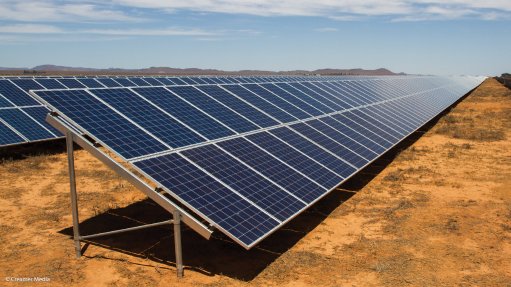
IEA says renewables are set to supply more than 60% of net demand growth in Africa between 2022 and 2024
Photo by: Creamer Media
South Africa’s new policy allowing power plants smaller than 100 MW for self-consumption or to connect to the grid and to sell power without applying for a generating licence may help address capacity issues in the short term, the International Energy Agency (IEA) states in a new report.
“A number of large industrial customers have already announced plans to build plants to power their own operations in response to this evolution in policy,” the IEA adds in the January edition of its semi-annual ‘Electricity Market Report’.
The report notes that, following a 5% contraction in electricity demand in South Africa in 2020, there had been a 3% year-on-year recovery during first ten months of 2021.
Ongoing capacity shortages, combined with their economic impacts, had led to declining electricity demand over recent years, however, during which “persistent load-shedding has become the norm”.
The IEA says it is premature to state what impact the 100 MW policy reform will have on demand.
“[However], as a country with a major energy shortage, South Africa could expect to see a boost in demand as capacity issues are alleviated by projects built outside the traditional auction process,” the IEA states.
For 2021, it estimates demand growth of about 2.7%.
The report states that South Africa is actively trying to address capacity shortages but also notes reliability issues with Medupi and Kusile as a problem, as well as delays to the 2 GW Risk Mitigation Independent Power Producer Procurement Programme (RMIPPPP).
Difficulties with the RMIPPPP “include the failure of the three power ships to obtain the necessary environmental permits to generate electricity at three different South African ports”.
The report also notes the conclusion of the latest renewable auction in October, but adds that the facilities are not expected to enter operation before 2024.
“New policy may help address capacity issues in the short term, as licensing obligations for embedded generation (i.e. demand-side generation) have been relaxed,” the report adds.
In December, Eskom announced that it would make 36 000 ha of land available in the grid-rich Mpumalanga province for private renewables projects and that its bidding criteria would “favour generators for size and speed of delivery”.
The utility estimates that the current supply deficit is between 4 000 MW and 6 000 MW.
In its analysis of the African electricity market, meanwhile, the IEA estimates that electricity supply across the continent grew by 5.6% in 2021 and is forecast to grow by a further 5% in 2022.
The majority of the new capacity due to come online over the coming years will arise from a host of renewables and gas projects, with renewables set to supply more than 60% of net demand growth between 2022 and 2024.
GLOBAL MARKET STRAIN & COAL SURGE
The recovery in the African electricity market in 2021 came amid surging global electricity demand, which created strains in major markets, pushed up prices and drove power sector emissions to a record high.
The report notes that the 6% rise in global electricity demand last year was the largest in percentage terms since 2010 when the world was recovering from the global financial crisis.
In absolute terms, last year’s increase of over 1 500 terawatt-hours was the largest ever, it adds.
About half of last year’s global growth took place in China, where demand grew by an estimated 10% and where coal shortages led to power cuts in the second half of the year.
Coal-fired generation grew by 9%, serving more than half of the increase in demand, and reached a new all-time peak as high natural gas prices led to gas-to-coal switching.
Gas-fired generation grew by 2%, while nuclear increased by 3.5%, almost reaching its 2019 levels.
In total, carbon dioxide emissions from power generation rose by 7%, also reaching a record high, after having declined the two previous years.
The IEA’s price index for major wholesale electricity markets almost doubled compared with 2020 and was up 64% from the 2016 to 2020 average.
For 2022 to 2024, the report anticipates electricity demand growing 2.7% a year on average.
On the supply side, renewables are forecast to grow by 8% a year on average, serving more than 90% of net demand growth during this period, while nuclear-based generation is expected to grow by 1% yearly during the same period.
“As a consequence of slowing electricity demand growth and significant renewables additions, fossil fuel-based generation is expected to stagnate in the coming years, with coal-fired generation falling slightly as phase-outs and declining competitiveness in the US and Europe are balanced by growth in markets like China and India.
“Gas-fired generation is seen growing by around 1% a year.”